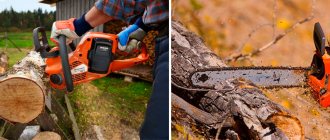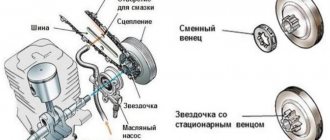Chainsaw oil
Content
- 1. Which chainsaw parts need oil?
- 2. How to choose chainsaw oil
- 3. Chainsaw oil ROLF Garden 2T
- 4. Physico-chemical characteristics
- 5. How to determine the ratio of gasoline and oil
- 6. Rules for preparing the fuel mixture
- 7. Choosing chain oil
Engine oil for chainsaws must meet a number of requirements. First of all, these are high thermal stability and anti-wear properties: when operating a chainsaw, especially in summer, the motor can heat up to high temperatures. Since the exhaust comes directly into the work area, minimal smoke is desirable. Taking these points into account, ROLF Lubricants GmbH creates a specialized oil for power tools and garden equipment with two-stroke engines.
Chainsaw chain lubrication system design
Components of the chainsaw lubrication system:
- oil tank (located in the crankcase, oil must be poured into it so that it flows to the chain);
- oil filter (installed inside the tank);
- oil line or oil-conducting hose (made of wear-resistant rubber);
- oil pump;
- worm gear;
- chainsaw tire (it has holes through which oil flows).
Video - what oil to use for a chainsaw chain:
Chainsaw oil pump design:
To get to it, you need to remove the clutch (the whole process can be seen in detail in the video. Thanks to the author of the video, Evgeniy Kravchenko, for the detailed story!).
This is what the oil pump looks like after removing the clutch:
Oil pump
The figure clearly shows the plunger, which has a groove on the tail. This groove is needed to capture the required portion of oil and supply it through the hose to the saw bar and further to the chain. The rotation of the plunger is given by the clutch drum sprocket. Accordingly, we obtain the required amount of oil at any engine speed, since engine speed and plunger rotation speed are interrelated.
Plunger Stihl MS 210,230,250
Many chainsaws have the ability to adjust the amount of oil supplied. Adjustment is carried out by rotating a screw, which reduces or increases the amount of oil captured by the plunger. The screw is located underneath the pump. (see photo).
Adjustable oil pump
Chainsaw sprocket lubricant
To increase service life and reduce friction on the drive sprocket, the manufacturer equips this mechanism with a needle bearing, which must be periodically lubricated. Stihl Multi-Purpose Grease can be used for lubrication.
If you do not want to overpay, it is better to use an inexpensive, but no less high-quality option, Litol or Litol 24 lubricant. Due to its viscosity, Litol will easily replace the original one.
You can lubricate the chainsaw tire sprocket with the same lubricants as the drive one, using a special syringe for this. This allows grease to be pressed through the technological holes in the tire to the sprocket bearing.
Products from the world's leading manufacturers
Many owners are wondering: what is the best chainsaw oil? Of course, a lot can be said about the chemical characteristics and specific properties and characteristics of various types of oils, but these selection criteria are not available to the average consumer. for this reason, the choice of suitable oil can be based on the proposals of the world's leading companies that monitor quality and prevent low-quality products from entering the market.
And so, this item will answer your question and here you will get acquainted with a couple of the most popular manufacturers, whose products are of high quality and affordable prices. So:
How to use oil from the German manufacturer Stihl
Today, oils of this brand are very popular among Russian manufacturers (see oil for Shtil chainsaws). Basically, our stores provide products of this company in 0.1 or 1 liter volumes. This oil is perfect for both conventional and professional chainsaws.
This type of chainsaw chain oil, the price of which for a small bottle is about 100 rubles, and a large one - 300 rubles, is of high quality and reliable operation, since it completely protects the mechanism of your tool. Read about Shtil chainsaws.
Huksvarna chain oil viscosity
There is no significant difference between this manufacturer and the previous one. Naturally, when you go to a specialized store, you will be advised to use oil exclusively from the manufacturer whose machine your chainsaw came from, but, unfortunately, it is not always possible to purchase exactly the “native” oil, then in this case another one will be perfect, the main thing is that it it was of high quality and from a well-known manufacturer (see Huksvarn chainsaws).
Main characteristics
The Shtil chainsaw chain lubrication system consists of:
- guide bar;
- saw chain;
- oil pump.
The oil supply by the pump has a special adjustment. The chainsaw chain is lubricated constantly during operation of the device. Therefore, chainsaw chains have a long service life.
During operation, the chain requires a constant supply of lubricant. Its continuous supply must be ensured. This is required by the design of the device. While the chainsaw is running, the oil leaves the bar groove and is instantly absorbed by the sawdust.
For this reason, the chain is lubricated automatically. Some chainsaw chains are equipped with a system that regulates the exact amount of lubricant supplied. The cheapest devices are equipped with a hand pump, which is powered by a drive located on the handle.
Scheme for checking the operation of the chain lubrication system.
A special oil has been specially developed for good chain lubrication. After use, it quickly decomposes, so there is no disruption to the ecological system. You can also use the following brand oils:
- M6;
- M8.
The gear lubricant is absolutely not suitable for the job. In winter, it hardens, as a result the oil system becomes clogged, and you have to clean it completely.
In winter, chain lubrication requires special attention. in severe frost it thickens and resembles Vaseline. Therefore, to operate in winter, it is necessary to lubricate chainsaws with special winter oil, which has a thinner consistency.
It is not always possible to purchase such a lubricant. To solve the problem, diesel fuel is mixed with oil, the viscosity is reduced. However, if the previously filled oil remains in the crankcase, then adding diluted oil will not have a positive effect; the system channels will remain clogged. There is only one way out - heating the chainsaw in a warm room.
If the chain oil does not solidify too much, you can try to melt it by running the saw at low idle speed.
Main manufacturers
Leading manufacturers of chainsaws produce consumables and lubricants for them, including those specifically for chains and tires. All other things being equal, preference should be given to the products of the manufacturer of the chainsaw itself. But the quality of the best brands is such that using lubricants from another manufacturer will not have a negative impact on performance.
The most famous brands are the German company STIHL, the Swedish Husqvarna and the Japanese Makita. They provide a fairly wide selection of adhesive oils, including the following:
- mineral Stihl ForestPlus is designed to work at temperatures down to -15 ℃. Standard packaging – 1 and 5 l. For long-term work, it has recently been produced in 20-liter containers;
- The highly environmentally friendly Stihl BioPlus is produced on a plant basis. Once in the soil, it quickly decomposes without polluting it. The operating temperature is also up to -15℃. Packaging – 1 and 3 l;
- For low temperatures, semi-synthetic Stihl SynthPlus is suitable, operating down to -25 °.
- Eco-friendly, biodegradable Bio and Bio Advanced. Presented as a universal all-season oil. Bio Advanced option - improved oxidation resistance and up to 10% better lubricating properties;
- Makita. Biotop oil;
- Champion adhesive oil.
Among the Russian brands specifically for chains there is “ZUBR ZMPM-M”. There are also other, less well-known manufacturers whose lubricating oil is noticeably lower in price.
Main brands of motor oils for chainsaws
The leaders in the production of high-quality lubricants for chainsaws and brush cutters are the companies Shtil and Husqvarna. Their range includes both conventional mineral lubricants for two-stroke engines and synthetic oils for severe operating conditions. Let's take a closer look at the range.
STIHL HP
STIHL HP mineral lubricant was specially developed by STIHL engineers for use in their tools. That is why owners of Shtil chainsaws and lawn mowers are recommended to use this type of oil.
Its color is red, shelf life in a closed container is no more than four years. It is packaged in several types of containers, so you can choose the most convenient packaging for yourself. Not so long ago, convenient containers of 20 grams appeared, which are diluted with one liter of gasoline. For those who rarely use a chainsaw, this is the best option. Can be diluted and used immediately.
STIHL HP fully complies with high European standards.
HP Ultra
Another oil from Stihl. It has a synthetic base, due to which it has improved combustion characteristics, cleanliness and engine protection.
Recommended by the manufacturer for long-term use in harsh conditions. Ideal for working at low temperatures. HP Ultra does not harm the environment, since oil spilled on the ground decomposes by 80% in just 21 days.
Packaged in two types of containers, 100 ml and liter bottles. The proportion of the finished fuel mixture is 1:50, which means a 100 mm bottle is enough to prepare 5 liters of the mixture. Green color. Shelf life 4 years.
The cost of this oil is significantly higher than the cost of STIHL HP, so it is not profitable to use it constantly.
It is worth noting that Stihl oils, before going on sale, go through the company’s laboratory, where they are tested to ensure they meet all requirements.
When developing oils, much attention is paid to fuel combustion, cold start characteristics, biodegradability, and viscosity change at different temperatures (information from the company’s official website)
Husqvarna HP 2-stroke
Husqvarna HP oil, like its STIHL HP counterpart, is also designed specifically for 2-stroke engines.
According to the manufacturer, this type of oil has additives that compensate for the low quality of fuel, which is important for our country. The declared octane number of gasoline at gas stations rarely corresponds to the real one.
Husqvarna HP – semi-synthetic, green. Packaged in liter or ten liter containers. The proportion of the mixture is 1: 50, i.e. 20 grams per liter. During the period of running in the saw engine or when working in cold weather, it is possible to increase the proportion to 1:40, which will give the engine greater protection and increase its service life.
Today, there are a large number of lubricants for two-stroke engines on the market from different manufacturers. For this reason, answering the question of which chainsaw oil is best is quite difficult. Our opinion is that you should trust reliable companies, which are Shtil, Husqvarna, Oregon, Champion. It is their oils that will maximize the protection of your tool’s engine and extend its service life.
Unscrupulous manufacturers often disguise their products under well-known brands (Husqvarna, Shtil, etc.). Such oils are of low quality and can harm the engine. In order not to be deceived, it is necessary to purchase lubricants from official representatives who have the necessary certificates for the products. You can learn how to distinguish a fake from an original from the video:
Chainsaw chain oil
The chainsaw has two tanks, one of which is filled with gasoline, and the other with oil for lubricating the equipment’s chain. The durability and serviceability of the chainsaw will depend on the quality and composition of the oil, as well as fuel. Often, hardware stores offer ready-made oil from chainsaw manufacturers ; it is intended for this purpose.
The finished product is suitable for use at low temperatures and does not pollute the environment. The finished oil can be replaced with another, the main thing is that it is not used. Representatives of equipment manufacturers recommend buying branded oil or preparing a mixture based on the one specified in the operating instructions. If the instructions do not specifically indicate the type of oil, then you can buy two-stroke oil, which is sold in a specialized store. Two-stroke oil can be of two types:
- Mineral
- Synthetic
Experts advise using synthetic oil for chainsaws, but it is always more expensive. The main advantage of this type of lubricant is that during operation of the equipment, carbon deposits do not form in the cylinder , and this extends the service life of the equipment.
If mineral oil has been used for 100 working hours, then it is better to continue to use it, since carbon deposits may have accumulated during operation. The synthetic product has the property of cleaning and will wash away the deposited layer from the cylinder walls, and this will lead to damage to the equipment.
Chainsaw chain oil
Post by Gena » June 27, 2015, 12:32 pm
Re: Chain oil
Post by Vadim_Mk » June 27, 2015, 2:03 pm
How should a chain oil lubrication system work?
To ensure reliable operation of the chainsaw, a special chain oil lubrication system is installed. An example is the following information:
Fuel tanks are selected by volume, taking into account that when the fuel is completely used up, some oil should remain
In addition, it is important to correctly set the carburetor so that fuel is not quickly produced. With a slow decrease in oil at the time of use of the saw, the lubrication efficiency decreases several times, and the conductivity of the channels also decreases. Over time, a malfunction may appear that will be quite difficult to fix. It is recommended to check the condition of the oil pump from time to time
If necessary, you can adjust the performance using a special screw. You can check the correct operation of the pump yourself. To do this, the tire is brought to an illuminated surface. If oil splashes appear on it, then the design is working correctly. Lubricant consumption is adjusted depending on the specific situation.
Saw chain lubrication system
A sign that an insufficient amount of lubricant is getting into the cutting zone is strong heating and the appearance of smoke and an unpleasant odor when cutting wood. When heated strongly, the metal expands, causing the chain to become pinched in the groove. The effectiveness of the degree of lubrication decreases when the tire gets into the ground. That is why, if the saw is not used carefully, it will quickly wear out. When chain oil comes into contact with the ground, it collects various substances, due to which the heating of the metal accelerates.
Basic malfunctions and repairs of the chain lubrication system
Let's look at common malfunctions and repairs of the chain lubrication system of modern chainsaws.
If the chain is not lubricated
The tank is full, but the oil does not flow to the chainsaw chain. There could be several sources of the problem here.
- Oil pump drive failure. Quite a common malfunction. On Stihl chainsaws, it is common to cut off the flange of the plastic drive gear. Or the splines are worn out. The gear does not rotate at all or rotates but does not engage the pump drive.
Uneven supply of lubricant
The chain receives too much or too little lubricant. When oil does not flow to the chain or is poured too much, it causes discomfort during operation and can damage the saw. This problem is a little less common, but also quite widespread. There may be several reasons.
- Incorrect adjustment. It is better not to touch the oil supply adjustment screw on some saws without understanding the adjustment process.
- Use of lubricants of unsuitable viscosity. The pump pumps lubricants that are too thick less readily, and they are less easily distributed by the chain along the tire. With liquid oils the opposite is true.
- Reduced tightness in the chain lubrication system. Sometimes the oil supply tube to the pump comes off or is damaged. This causes oil starvation. A similar problem manifests itself in lubricant leaks at the bottom of the chainsaw.
Overheat
Despite the abundant supply of oil to the chain, overheating or jamming is still observed. There is only one reason here - the use of a material that is absolutely unsuitable for lubrication. This can often be seen when pouring into the mining system.
Lubrication system malfunctions and how to fix them
The main malfunctions of the oil supply system on a chainsaw can be divided into two main types: these are general malfunctions inherent in all chainsaws and individual ones, which may vary depending on the type of pump and worm gear installed on a particular model. Let's begin to understand the faults in order.
Operating a chainsaw without lubricating the chainsaw chain is prohibited. This has a detrimental effect on the bar, drive sprocket and chain, and can result in significant repair costs.
Signs of a malfunction of the lubrication system, checking its performance
- The chainsaw chain is dry and has a pale tint without shine.
- The chain stretches relatively quickly.
- The tire is very hot and may even partially melt the paint.
- The oil from the tank is practically not reduced.
- Reduced cutting efficiency on a sharp chain
All these signs indicate that the lubrication process is not proceeding properly. In order to check the oil supply to the lubrication system, you need to remove the side tire of the chainsaw and start it. Next, you need to slightly increase the speed while observing the end of the oil line. If oil comes in, most likely the amount is not enough for normal lubrication and you need to clean or replace the filter and, if possible, adjust the flow. If it does not, the problem is more serious and requires further diagnosis.
There is a way to check the oil supply without removing the tires. To do this, you need to point the end of the bar towards, for example, a freshly cut piece of wood from the side of the cut and increase the speed as much as possible, while trying to keep the end of the bar at a distance of no more than 10 cm from the block. If oil spots begin to appear on its surface, it means the oil is being supplied.
Troubleshooting
Once it has been determined that oil is not being supplied, further diagnosis is only possible if the oil system is completely removed. Of course, in some situations replacing the filter helps, but this is very rare.
Access to the oil pump of some models of saws is possible only after complete disassembly; therefore, without having the skills to repair gas-powered tools, it is better to entrust repairs to professionals.
Most common faults
- Broken oil hose. It can sometimes be detected by visual inspection. The problem is solved by replacing the faulty part.
- There is no thread on the oil pump shaft; replacing it will help.
- A defective thread on the pump drive gear can be similarly solved by installing a new part.
- Lack of main shaft corkscrew (relevant for some instrument models, for example, Homelite). You can fix it by installing a nail of a suitable diameter instead of the original corkscrew, cutting it to the required length.
- Blockage in the line. Can be removed by blowing with compressed air or mechanically, using a wire of a suitable diameter.
- Filter element clogged.
- The Stihl MS 180 tool, whose pump is not dismountable, often gets clogged. You can try to wash it in clean gasoline, if that doesn’t help, replace it.
- In Chinese chainsaws (Gypsy), it very often cuts off the grooves on the main gear, through which the force from the sprocket is transmitted to it.
Individual malfunction of the Stihl MS 180 lubrication system
Due to the fact that the Stihl MS 180 is one of the most common models of chainsaws, I would like to dwell in more detail on one fault inherent only to it and describe a method for eliminating it without replacing parts.
Quite often, on the Shtil MS 180 chainsaw, depressurization of the oil line is observed in the place where the oil line coming from the tank is installed in the saw body. The malfunction can be determined by the characteristic lubricant leaks on the bottom of the tool.
To eliminate the problem, you need to remove the chainsaw handle, remove the hose from the mounting hole, clean and degrease. After all these manipulations, apply sealant to the hose seat and install it into the chainsaw body.
You can learn more about troubleshooting and complete diagnostics of the lubrication system of the Stihl chainsaw by watching a video that shows the step-by-step process of disassembling and repairing the lubrication system.
Common problems (oil not flowing)
Malfunctions in the oil supply system occur quite often. To avoid problems and expenses for maintenance, you should familiarize yourself with the most common problems, and also learn more about the “sores” of your saw model.
How to check for lack of chain lubrication on a power saw? It’s very simple - there are characteristic signs:
- The chain has stopped shining and is dry
- The chain quickly stretched, although it was not used for long
- The chain is sharp, but sawing requires effort
- The tire heats up and the coating on the surface melts
- The oil in the tank does not decrease
All these symptoms indicate a system malfunction. Check the oil supply to find out why it is not getting to the chain.
- The hose is broken or loose
- The filter (or non-separable pump) is clogged
- The grooves on the gear are damaged
- There is a blockage in the oil supply hose (remove with compressed air)
- Defective gear thread
Now you know why the chain of the electric saw is not lubricated, and you can carry out diagnostics yourself. The main thing is to choose the oil and maintain the equipment promptly!











